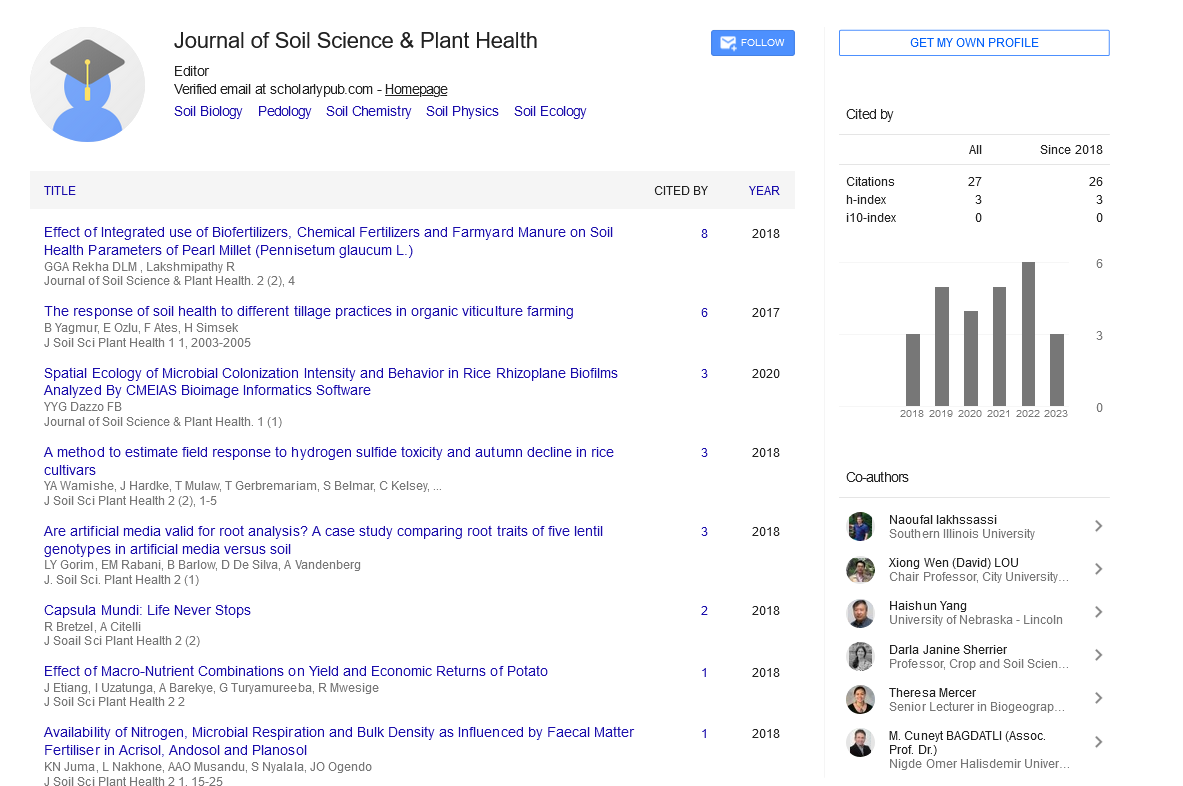Commentary, J Soil Sci Plant Health Vol: 8 Issue: 1
Soil-Plant Interactions in Phytoremediation of Contaminated Sites
Kim Jong*
Department of Agricultural Sciences, Mekelle University, P.O. Box 231, Mekelle, Ethiopia
- *Corresponding Author:
- Kim Jong
Department of Agricultural Sciences,
Mekelle University,
P.O. Box 231,
Mekelle,
Ethiopia
E-mail: kim123jong@gmail.com
Received date: 27 October, 2023, Manuscript No. JSPH-23-118468;
Editor assigned date: 30 October, 2023, PreQC No. JSPH-23-118468 (PQ);
Reviewed date: 13 November, 2023, QC No. JSPH-23-118468;
Revised date: 05 January, 2024, Manuscript No. JSPH-23-118468 (R);
Published date: 12 January, 2024, DOI: 10.4172/jsph.1000216
Citation: Jong K (2024) Soil-Plant Interactions in Phytoremediation of Contaminated Sites. J Soil Sci Plant Health J 8:1.
Description
Contaminated sites, a consequence of industrial activities and improper waste disposal, pose a significant environmental and public health challenge worldwide. Traditional methods of soil remediation often come with high costs and potential side effects. In response, phytoremediation has emerged as an environmentally friendly and cost-effective alternative. The complex world of soil-plant interactions in phytoremediation and explores the mechanisms by which plants can remediate contaminated soils.
Phytoremediation is a green and sustainable approach that uses plants to remove, immobilize, or degrade contaminants in soil and water. It offers a non-invasive and cost-effective solution to a wide range of contaminants, including heavy metals, organic compounds, and radionuclides. Key mechanisms of phytoremediation include phytoextraction, phytostabilization, and phytodegradation.
Phytoextraction is a process by which plants take up contaminants from the soil into their roots and above-ground biomass. This mechanism is particularly effective for heavy metals and metalloids. In this process, soil-plant interactions play a crucial role:
Contaminants are taken up by plant roots and transported to the above-ground parts of the plant. This uptake is mediated by plant root characteristics and the chemical nature of the contaminants.
The rhizosphere, the soil zone surrounding plant roots, is a hotspot of biological activity. Here, the roots release exudates, attracting microorganisms that can assist in contaminant solubilization and uptake.
Phytostabilization involves the use of plants to immobilize contaminants, preventing their migration to the surrounding environment. It is particularly effective for metals and metalloids that are not readily taken up by plants. Soil-plant interactions in phytostabilization include:
Some plants can accumulate contaminants in their root systems, effectively immobilizing them in the soil. This is especially common for metals that form complexes with organic ligands.
The rhizosphere is modified by plant roots, which release exudates that can alter soil pH and redox conditions, affecting the solubility and mobility of contaminants.
Phytodegradation involves the use of plants and their associated microorganisms to break down organic contaminants. This process relies on a range of biochemical interactions, including:
Plant roots release exudates that attract soil microorganisms capable of degrading organic contaminants. This is particularly effective for hydrocarbons and organic pollutants.
Some plants have metabolic pathways that allow them to metabolize and detoxify organic contaminants, converting them into less harmful forms.
Plant selection and soil conditions
The success of phytoremediation relies heavily on plant selection and the conditions of the contaminated site. The choice of hyperaccumulator plants, which can accumulate high concentrations of contaminants, is critical for phytoextraction. Similarly, selecting native or adapted plants can enhance the chances of success. Soil properties, such as pH, organic matter content, and microbial communities, also influence soil-plant interactions and the effectiveness of phytoremediation.
While phytoremediation offers numerous advantages, it is not a one-size-fits-all solution, and there are challenges to consider:
• The effectiveness of phytoremediation depends on the type of
contaminant and the plant species used. It may not be suitable for all
contaminants.
• Phytoremediation can be a slow process, requiring several growing
seasons to achieve significant results.
• Harvesting and disposing of contaminated plant biomass can be
complex and expensive.
• Sites may require long-term management to ensure contaminants do
not re-migrate.
Conclusion
Phytoremediation harnesses the natural potential of plants to restore contaminated sites, offering an environmentally friendly and costeffective solution. Soil-plant interactions are at the heart of this process, involving complex mechanisms that can mobilize, immobilize, and degrade contaminants. While phytoremediation is not without its challenges and limitations, it represents a valuable tool in the quest to remediate contaminated sites and restore the health of both ecosystems and communities. As research in this field continues to advance, our understanding of soil-plant interactions in phytoremediation will contribute to more effective and sustainable remediation practices.
 Spanish
Spanish  Chinese
Chinese  Russian
Russian  German
German  French
French  Japanese
Japanese  Portuguese
Portuguese  Hindi
Hindi 